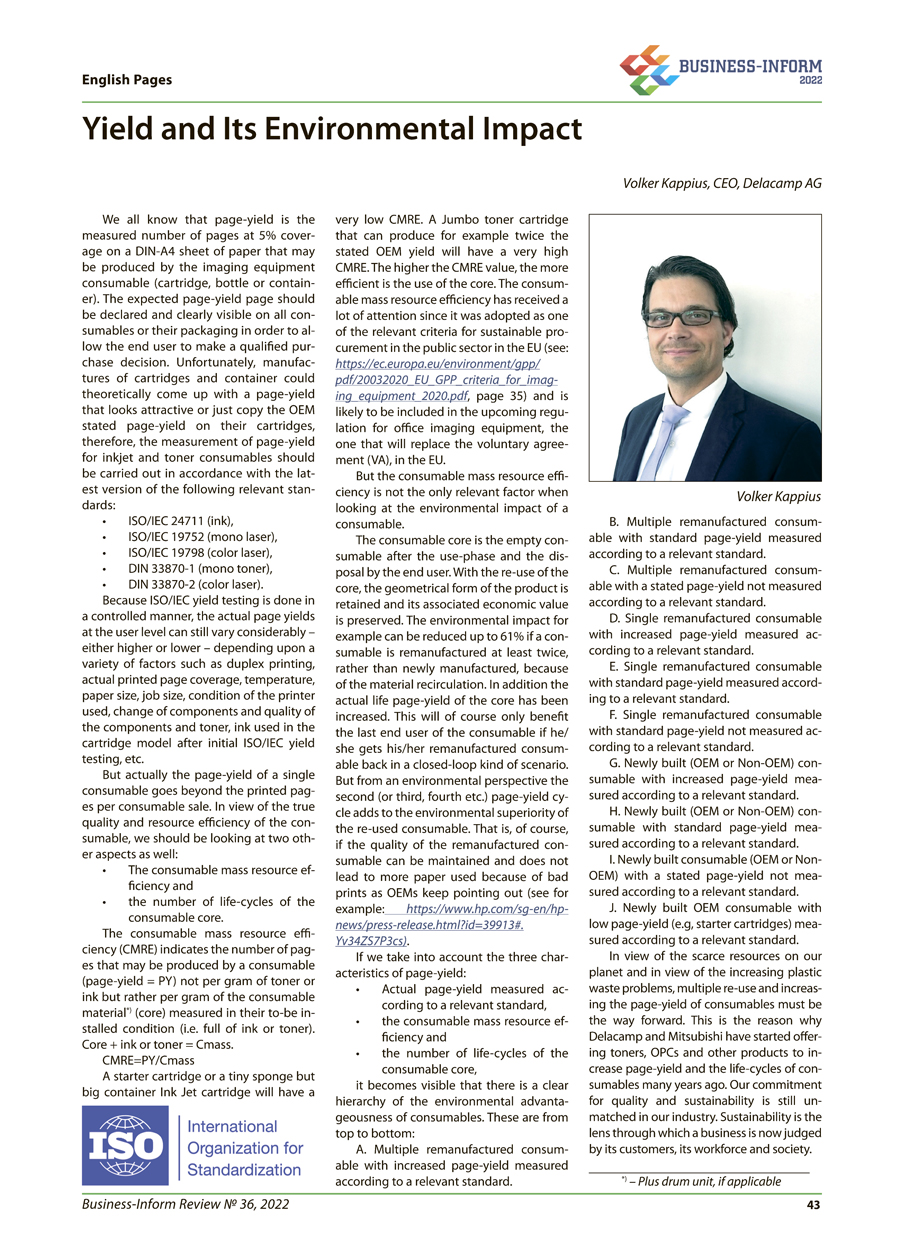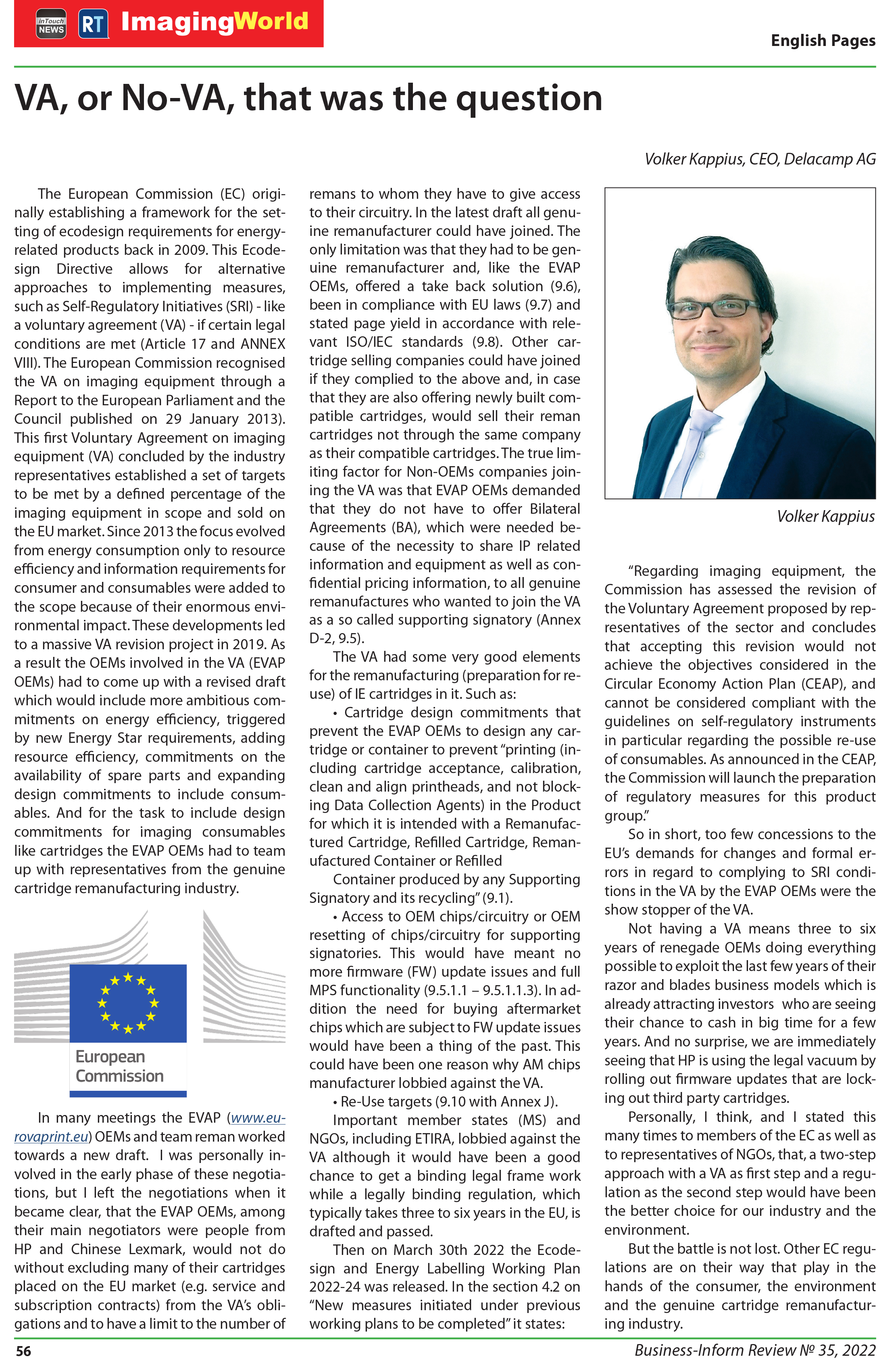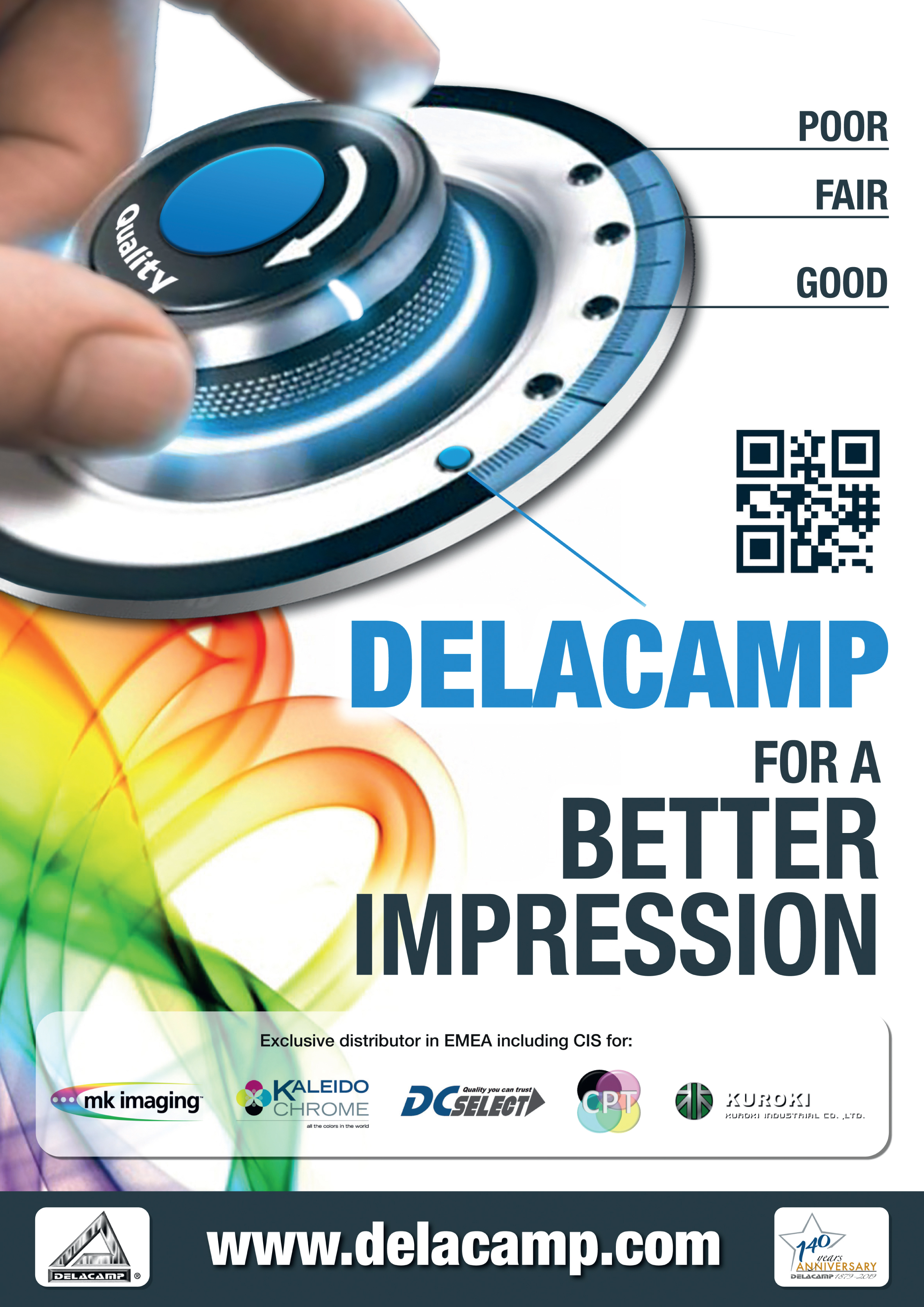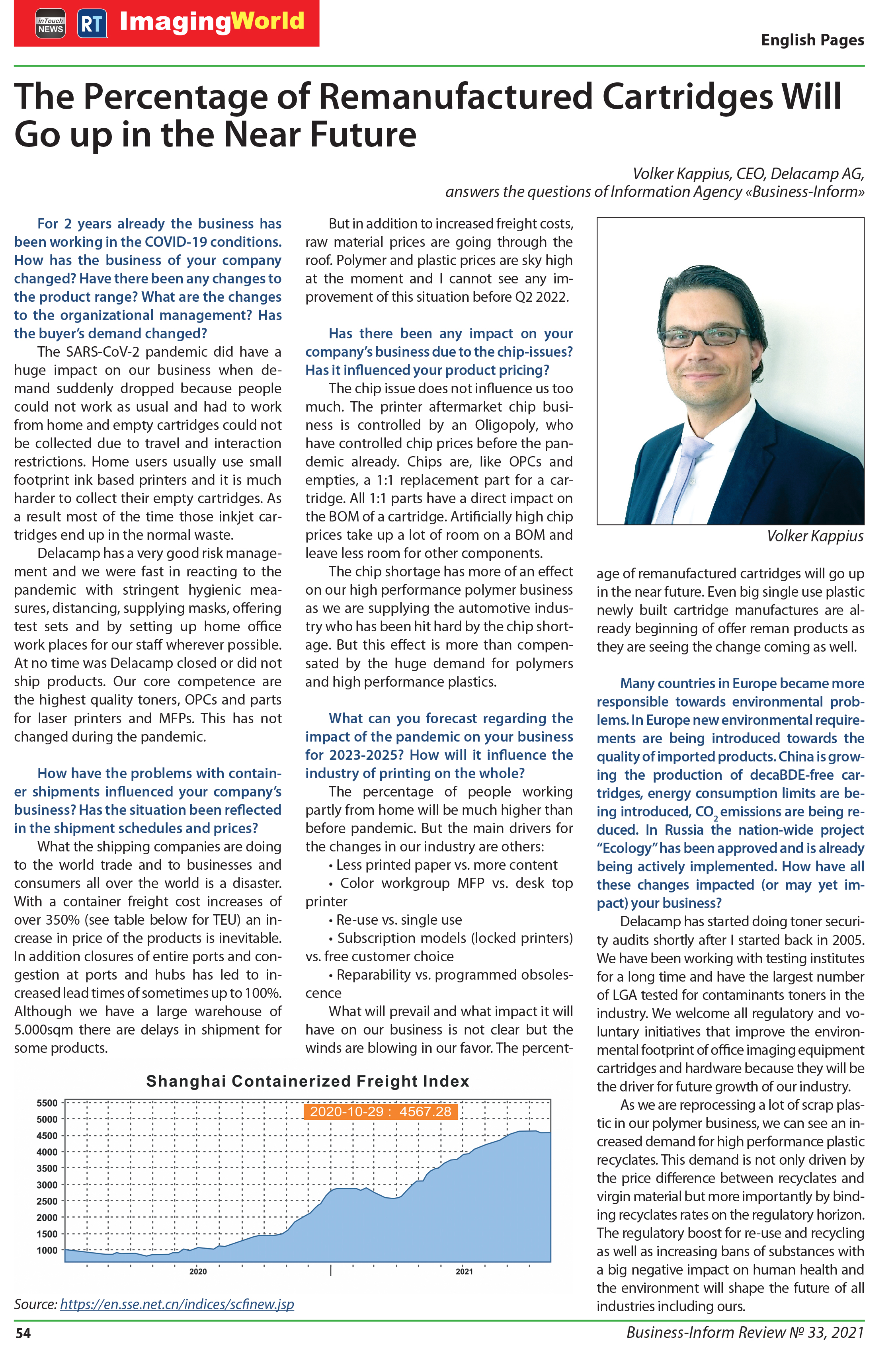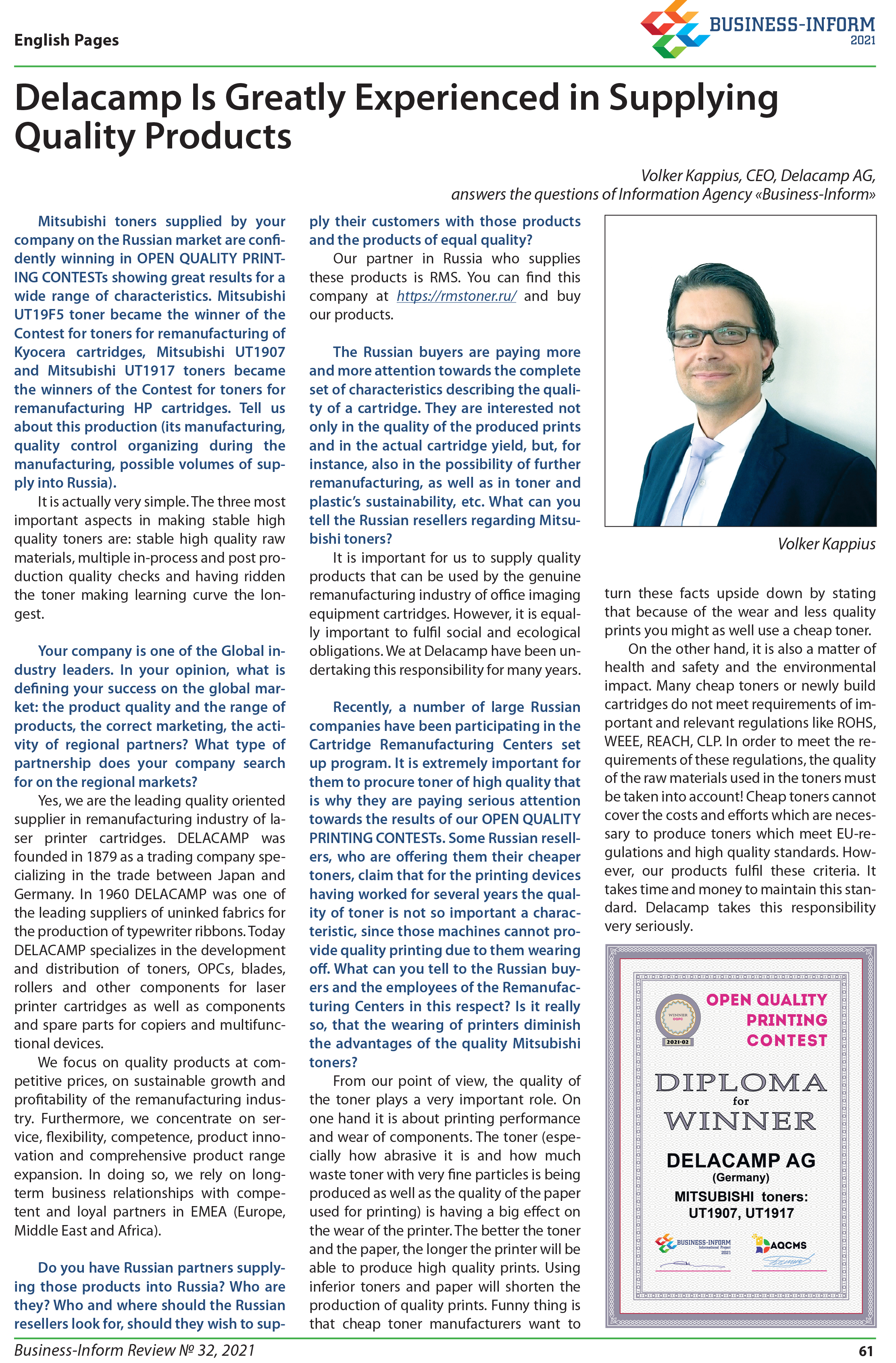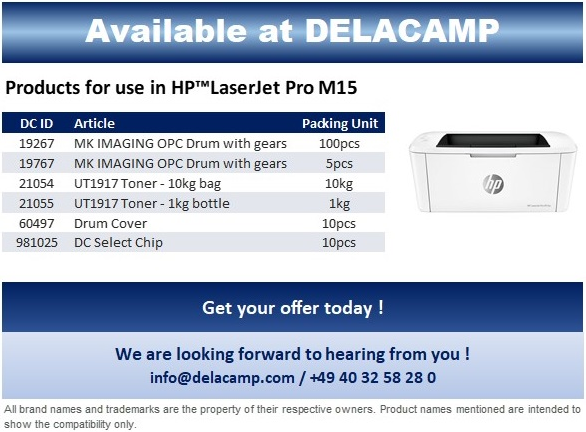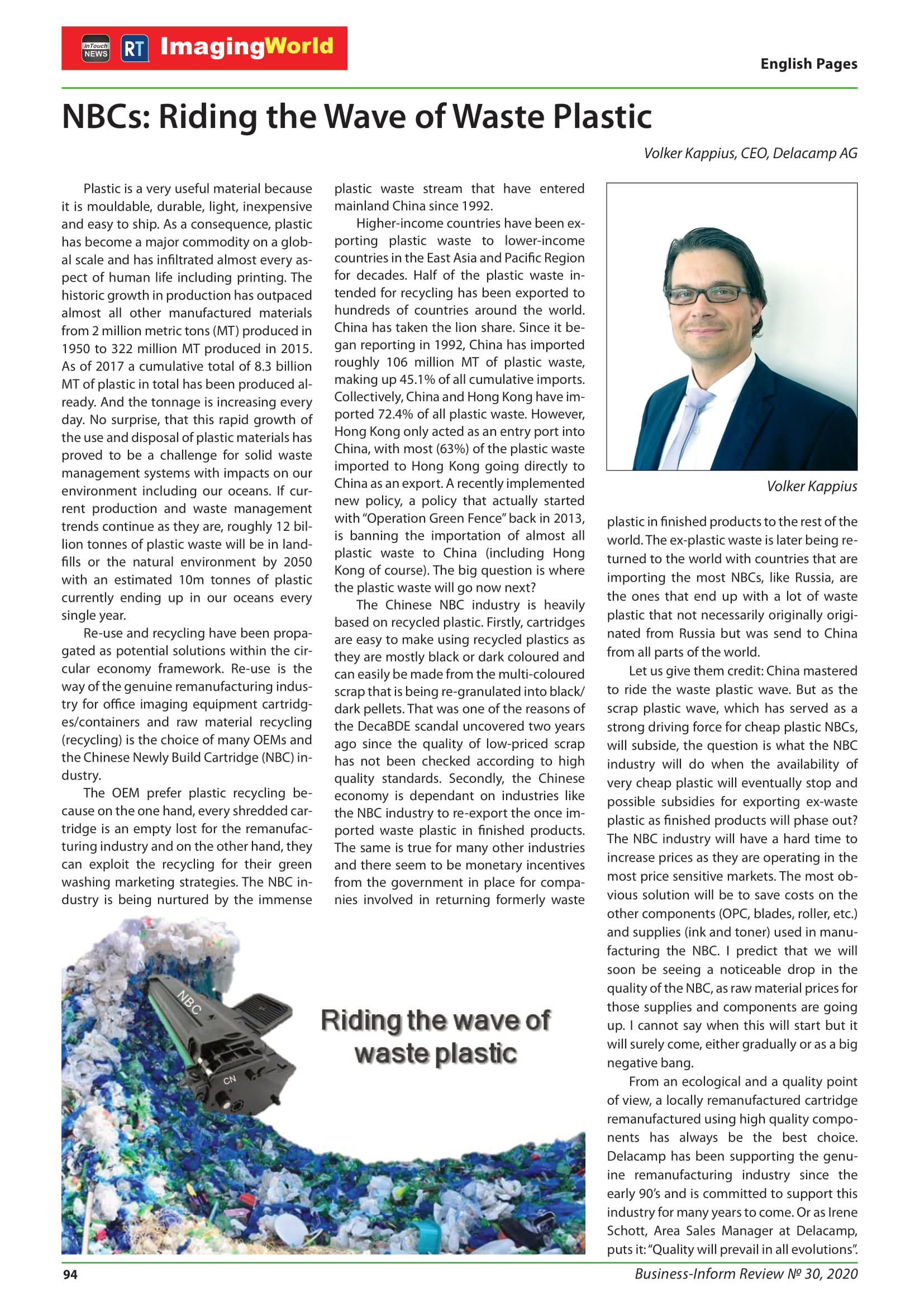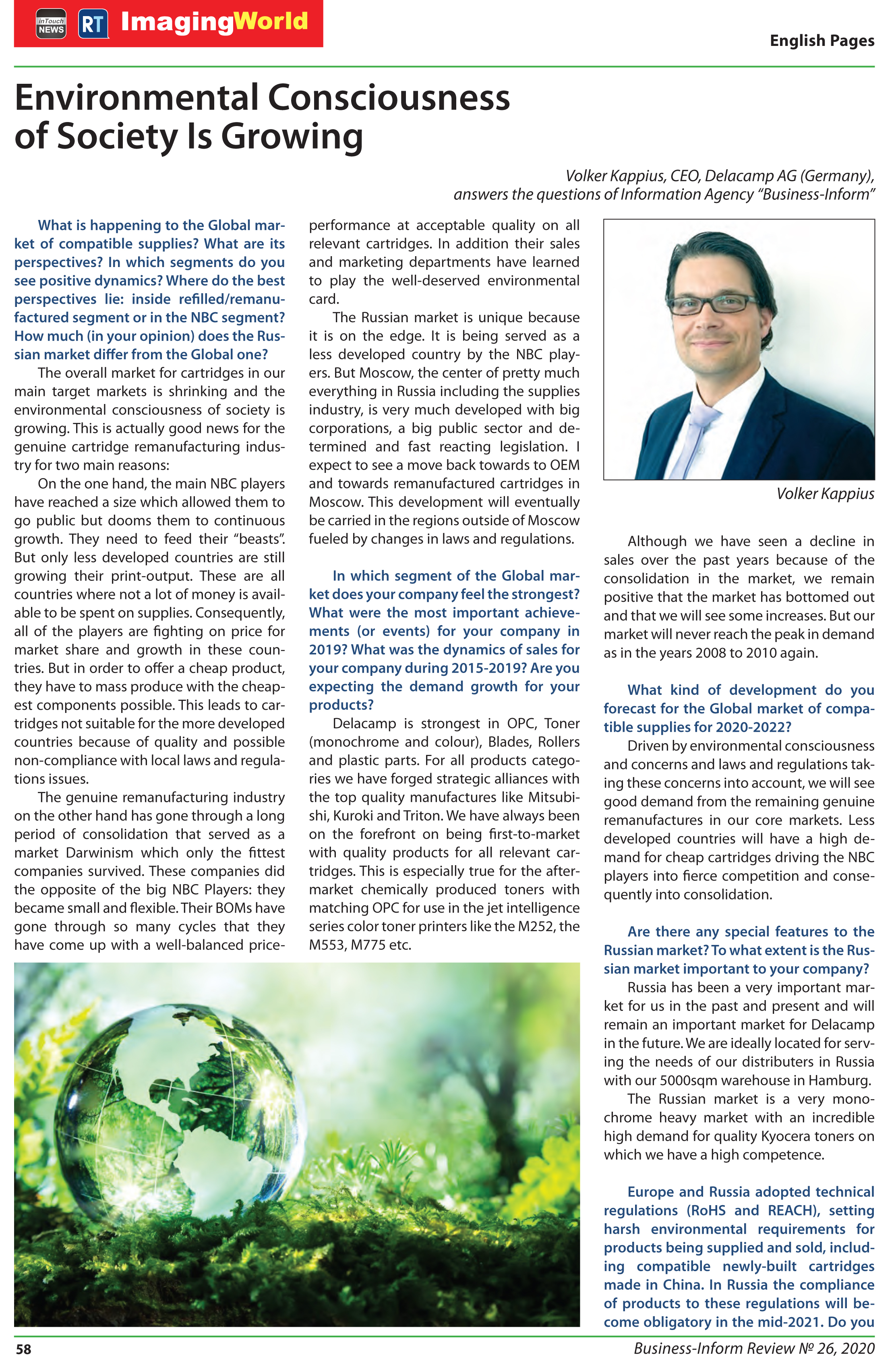|
B4/C3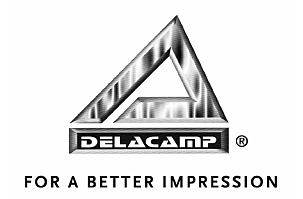
DELACAMP AG
Germany
Bargkoppelweg 64, Hamburg, 22145
DELACAMP, with its main office located in Hamburg, Germany is a leading supplier of components and consumables to the remanufacturing industry as well as consumables, components and spare parts for copier machines worldwide. In order to provide superior service to its customers, Delacamp holds a large selection and inventory of matched quality components at competitive prices for immediate delivery. DELACAMP is the exclusive distributor of MK Imaging, DC SELECT, CPT and Kaleidochrome branded products in EMEA. DELACAMP: Serving customers since 1879.
For more Information on DELACAMP visit their website at www.delacamp.com.
PRODUCTION: Consumables for the Recycling of cartridge: toner, drums, spare parts
Information from DELACAMP AG
19.03.2022 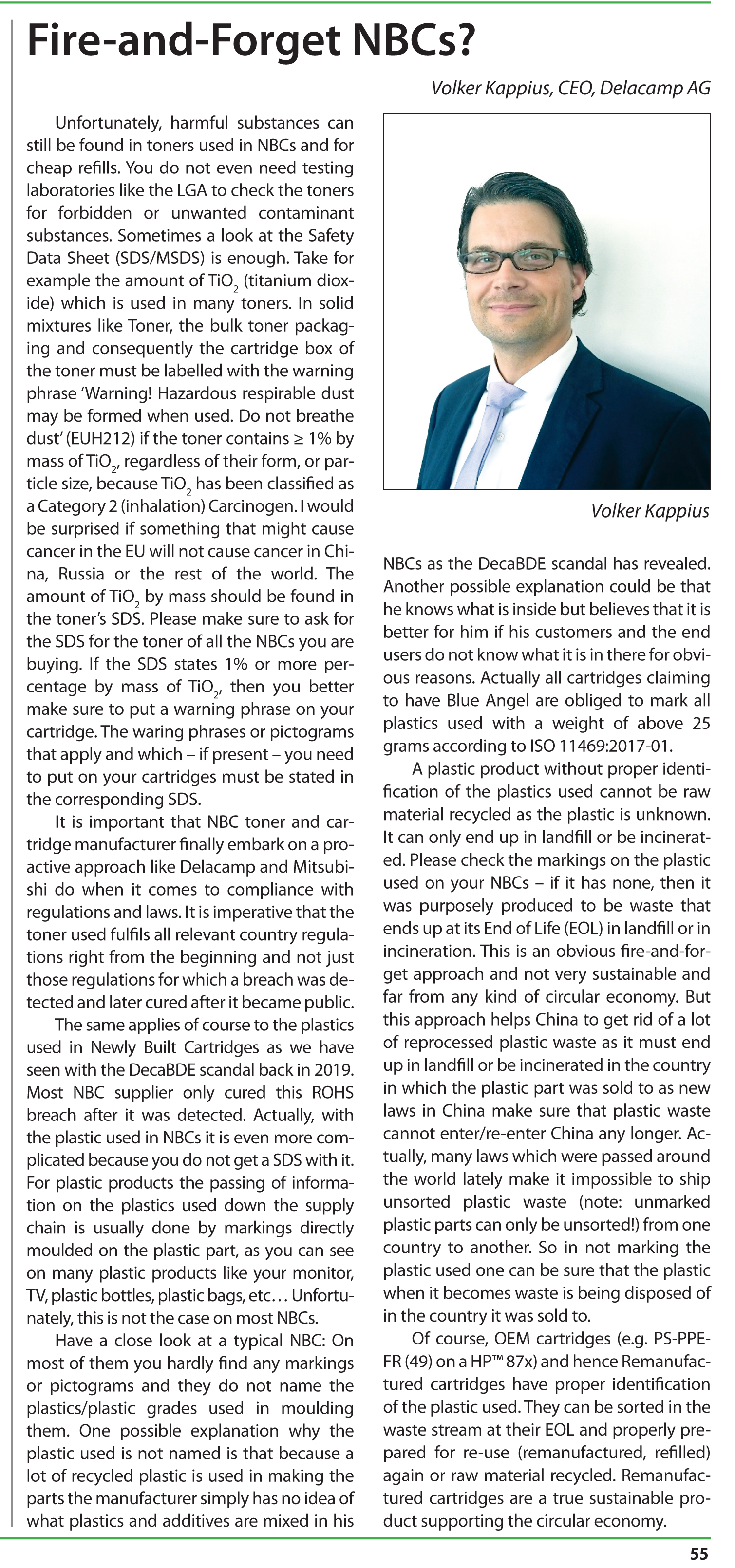
09.09.2021
Myth busting a moving target
Volker Kappius, CEO Delacamp AG
Single-Use cartridges, or better
single-use by design cartridges, need to be a thing of the past. Delacamp has
been actively supporting the genuine office imaging equipment cartridge
preparation for re-use, what we call remanufacturing, industry for many years
starting at a time when most other players have not been around or have been
active in other industries before embarking on the imaging reman industry.
OEM single-use plastic cartridges have
been the main target for the genuine reman industry as they come with the OEM
printers, replacement cartridges are heavily overpriced and reman companies can
fast learn how to remanufacture them as the components used are pretty much
standardized around the globe. With a used OEM cartridge (core) you know what
you get and with what you need to use and do to remanufacture it as quality
aftermarket components distributors like Delacamp will quickly offer full
solution of components, spare parts, OPC and toners needed for the
remanufacturing.
With the rise of the newly built
cartridges (NBC) this picture has changed. NBCs are also single-use be design
plastic cartridges. They do not come with the printer and they are very cheap
in price and often in quality. But depending on their market share in a given
market, they need to become a target for remanufacturing because they are the
only easy to get cores. The issue with the newly builds is that unlike with the
OEM core each Newly build is a moving target because the inner cartridge design
as well as the components used are not only different among the different
manufactures of newly builds for a given OEM cartridge type but can also vary
within one cartridge type of one manufacturer because of constant pressure to
keep low prices.
These moving targets, even if those
cartridges seem to be reman friendly because they have a fill hole for example,
are in fact a remanufactures nightmare because his standard “tool box” for the
cartridge is not fixed but needs to be adopted depending on the innards found
in each core.
In order for the newly built cartridges
to be a true myth buster, they need to have a stable quality not only in terms
of print quality but also in terms of the combination of parts used in any OEM
compatible cartridge. To make remanufacturing of these cartridges easier and
efficient, each change of components needs to be alerted to by a mark on the
plastic (e.g. mark I, mark II, etc.). Even better of course, would be the use
of components in a newly build that can survive more than one cycle and a
special web site of each manufacturer of newly built cartridges available to
cartridge remanufactures with tips on how to best remanufacture each cartridge
and their costs driven evolutions (e.g. mark I, mark II, etc.).
Furthermore, newly built cartridge manufactures should start to proactively use
non contaminated toners, components and plastic parts and not reluctantly react
if industry organizations find out that they are in breach of regulations, laws
and accepted health standards.
Without the above, the me-too green mask
of newly builds is just a lip service and re-fill shops will keep on refilling
the NBCs only because of a lack of OEM cores and to make the cheapest possible
cartridge for producing an output for which print quality is not important.
The newly built cartridge players in
China have become big corporations and are in most cases even listed companies
on Chinese stock exchanges. They have the size, the money and probably also the
know how to design and manufacture a much more sustainable product. But their reluctance
to do so only stresses that they are in for the quick money and not for the
environment and the health of their cartridge users. Their fire and forget
mentality still prevails.
This is the main difference between the
genuine reman and the newly built cartridge industry: Care (reman) vs. greed
(NBC).
18.02.2021
DELACAMP AG announced a new product -
LicoJet® cleaning tool
The latest product added
to Delacamp’s product range is a cleaning tool named LicoJET®.
It is a great tool for
cleaning IJ heads and used components. It allows precise cleaning with
compressed air and liquids. Super-fast working due to simple switching from
liquid to air-drying during the cleaning process is an excellent and timesaving
feature.
For more information on the above-mentioned or more of Delacamp’s
product range, visit www.delacamp.com or
contact us info@delacamp.com.
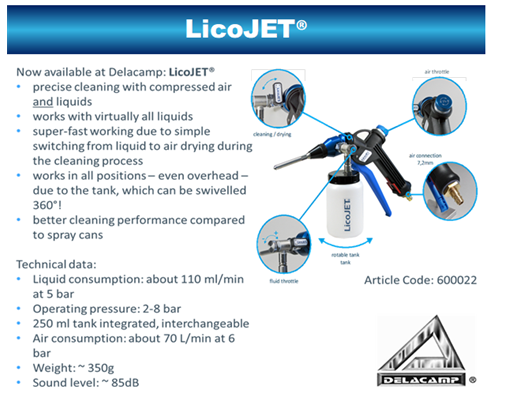
15.12.2020 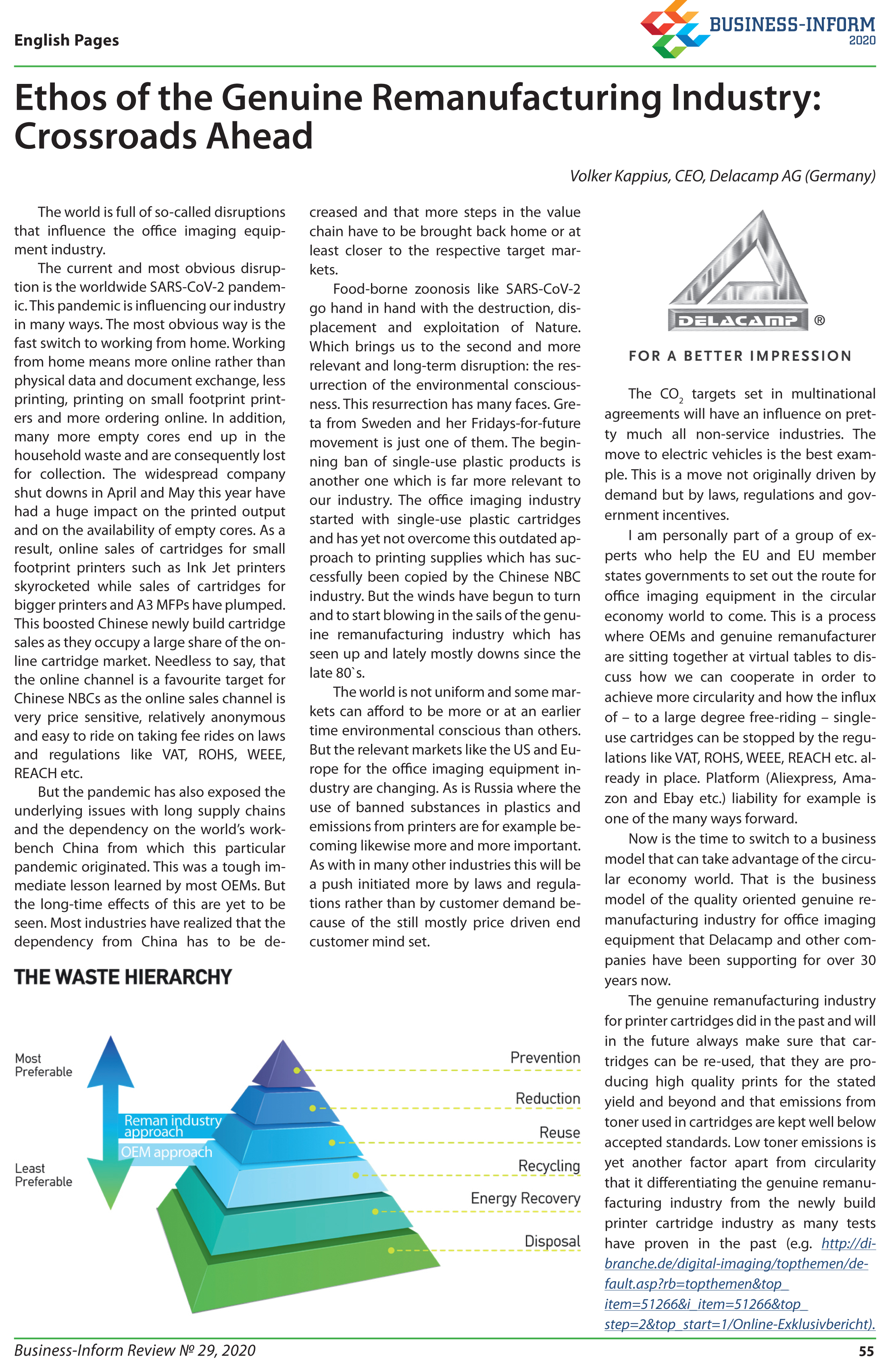
18.11.2020
Quality
cannot be proclaimed but needs to be proven and earned!
Volker Kappius, CEO, Delacamp AG,
answers the questions of Information
Agency «BUSINESS-INFORM»
- How in your opinion has the market of printing supplies changed in
2020? How has the COVID-19 pandemic changed the Global market and the work
of your organization?
The worldwide pandemic has been a big
disruptor. Lock- and shut downs are having a big negative influence on the
economic performance and having to work from home is having a big influence on
the availability of empties because household electronic waste can hardly be
included in collection systems. In addition home office users tend to use very
small footprint printers like small Ink Jet and laser printers. And since color
printing is very popular, the printers at home are mostly small foot printer
Ink Jet color printers for which supplies are being bought mostly online for convenience
reasons.
In order to minimize a possible impact of a
Covid-19 infection at Delacamp, we have some staff members working from home on
certain days but since pretty much everybody is having his own office and we
have implemented strict hygiene and social distancing measures at Delacamp the
number of people working from home is limited.
I have to admit that before I never ever had
more meetings with people outside of Delacamp per month. Online conferencing
has become a standard part of an office day in the pandemic and is definitely
here to stay even after the current pandemic is over.
- How interesting are the quality (and correspondingly more
expensive) printing supplies for the modern customer in the pandemic
conditions?
Although buying online is very convenient, having to return products
that do not work as expected and having to buy a replacement is troublesome. I
hate to admit it, but printing and printing supplies are low involvement items.
Users want to order and print. They do not want to worry about the supply until
the supply runs empty. This insert-and-forget mentality and demand can only be
satisfied by high quality and OEM supplies. But because users do not only want
to insert-and-forget but want to save money as well, high quality aftermarket
supplies are the product of choice during the pandemic. On top of that, the pandemic
has revealed that global supply chains are prone to disruptions. The local and
environmentally better alternative is in most cases the better choice.
- On what (in terms of Global market) do the sellers base the
evaluation of quality of consumables sold: their own experience, the
colleagues’ opinion, testing results, advertising? Can all consumables
sold on the Global market as “quality” ones be really attributed to being
quality materials?
“Quality” is not a registered trademark and everybody can use it.
Quality cannot be proclaimed but needs to be proven and earned. The perceived
quality of consumables is dependent on many factors. The factors include:
· Quality
(print output and emissions) of the components used in the consumable.
· The
way how these components are being assembled to manufacture the consumable.
· In-house
testing routines and methods.
· Paper
used for testing.
· Level
of regulatory compliance, etc.
Only testing in-house or by a trusted laboratory will give you security.
- Is it a must for distributors of quality supplies to have their
quality control laboratories? Or is it enough to have statements by
manufacturers confirmed with their certificates?
Testing by distributors of quality supplies only really makes sense if
the distributor, like Delacamp, offers the full range of products needed to remanufacture
a printer cartridge. If a supplier of toner only is doing testing, it will very
probably only be with an OEM cartridge where the toner is being dumped and
replaced by their own toner. This is not a realistic testing set up and
scenario. The same is true for all manufactures or distributors who only offer PCRs,
OPCs, etc. The only exception is chips. They can pretty much be tested with any
cartridge.
And
the impact of paper quality on testing must not be underestimated. Testing with
a soft white hue 80gr. smooth surface paper with little amount of chalk as a
filler will produce very different results than a 75gr. rougher surface and
high chalk content cheap paper.
- Who must explain to the customers the value of quality consumables:
manufacturers, distributors, resellers? Is it worth the money and energy at all?
The quality benchmark is the OEM. But the OEM is also the most expensive
and together with Newly Built cartridges from the Far East the least
environmental sound alternative. If we are to promote quality and educate the
end-user on quality it needs to be a team effort. The End-User has to
understand that the cartridge is made by a quality focused manufacturer using
quality oriented manufacturing and testing methods with the highest quality
components available with great service quality supplied by the distributor.
If one decides to save money and energy on quality he chooses to enter
the price-only ball game only. This is a game where you can only lose because
someone will always be cheaper. The shark tank is open to be joined by anybody
who wishes to throw quality over board.
- Should the customers trust the testing done by the supplier of
customers, since this type of testing almost always confirms “the high
quality” of the supplied product?
If the supplier has built track record of reliably supplying quality
products, than this supplier can be trusted and regular random checks can be
enough. But if the supplier has not be able to build a positive track record
and/or is selling different products/build specs under the same product code
you cannot afford not to test. It is your reputation that is at stake. The
reputation you have been building over many years.
- What in your opinion must be included in the term “quality of
printing supplies”? The quality of prints? Or the wider set of characteristics: the convenience for
remanufacturing, environmental friendliness, informational safety, etc?
For printing supplies there is an easy answer for me:
· Repeatable
quality of the print (ID, fixation, yield, level of background, color gamut,
gloss level, etc.).
· Emissions
(none or low) of printing consumable (Ink or Toner).
· Regulatory
compliance (in the target country of the printing supply).
· Environmental
impact of manufacturing and transportation.
· Complaint
management.
· EOL
(End-of-Life) solution.
22.10.2020
Mitsubishi Chemical
Corporation and Delacamp Announce the Prolongation of the Exclusive Distributorship for Europe, CIS, the Middle East and Africa
Delacamp AG, the largest independent
supplier of quality components and consumables to the genuine printer cartridge
remanufacturing industry has been chosen again by Mitsubishi Chemical
Corporation as their sole and exclusive distributor of OPCs and Chemical Toners
for Europe, CIS, Middle East and Africa.
“We are very delighted to continue this
long-term successful partnership and are proud to mark the 15th year
of successful cooperation with Mitsubishi in 2021.
The year 2020 is a difficult year. It
presents us all with new challenges. The global spread of the SARS-CoV-2 virus
and the measures to slow the virus spread affect both social life and the
global economy. We are all affected in some way and most of us have had
difficult months this year. I had been promoted to Sales Manager at the
beginning of this year and honestly speaking I expected my first year in the
new role to be quite a bit different. However, it makes me very proud working
with such a good team, customers and business-partners that let us get through
this challenging situation and year. I would like to use this opportunity to
thank our long-term business partners and absolutely loyal customers – thank
you very much!” says Susanne Dannehl, Sales Manager of Delacamp.
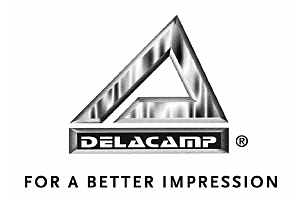
02.05.2020
Throw
Away the Concept of Throw Away
Volker
Kappius, CEO Delacamp
Successful business models and
products get copied. The degree of competition between original and me-too is
really only limited by how successful the business model or the products in
their respective markets are and how high the entrance barrier to move into
that particular market is. In most cases the perceived entrance barrier is much
lower than the actual one, because some entrants are willing to take the risk
to not to comply with all necessary requirements. In most
cases the more mature a new entrant into a market is and the more money he has
made in that market, the more he is likely to comply with more and more
requirements because he can now afford it and he needs the true height of the
entrance barrier as a shield against new entrants. No rocket science here.
The same principle only seemingly
applies to the imaging cartridge industry. At a first look one might argue,
that the OEM razor and blade business model was successful enough to be worth
copying, the entrance barrier to moving to machines was too high, the entrance
barrier to moving to selling single use cartridges seemed low. But this is not
how the cartridge imaging aftermarket industry started. Actual it started way
more disruptive. In the late 80s the pioneers of the cartridge remanufacturing
industry looked at a cartridge and the profitable business model but challenged
that a cartridge is a single use throw away product. Hence they started
collecting the waste empty cartridges and used them as a core to remanufacture
them in order to give them a second life and to have a product to compete
against the OEM single use cartridges.
This remanufacturing business model
was then seen by others companies as being lucrative enough to be worth
copying. So they did. But eventually it became too time-consuming and too
troublesome and expensive to collect empty cores in different countries, ship
them to their factories, remanufacture them and then send them back for sales
in the same countries where the cores have originally been collected. In addition
cheap raw materials and cheap plastics which had been partly derived from waste
plastic collected over years were readily available and were easy to be used
because black plastic can hide a lot. So instead of re-using a former
single-use plastic product, these companies made their own single-use plastic
products. Only they made it way cheaper than OEM products and even cheaper than
remanufactured products because the perceived entrance barriers into moving to
new single use plastic cartridges were low. We are now seeing that the main
companies who copied the remanufacturing business model but then moved into
single-use cartridges are trying to be more and more compliant but have not
fully overcome the true entrance barrier laid out by all necessary requirements
to be fully compliant in each target market.
Legal entrance barriers in to the
cartridge market are actually very high in most developed countries like
Russia, the EU countries and the US. Legal entrance barriers include among
others:
· IP
(civil law)
· Local
laws and regulations on health and safety, waste management, the environment,
importation, VAT and other taxes, etc. (criminal law)
Every time a mature player becomes more
compliant he usually flanks this by marketing activities as we can currently
see on IP compliance. IP compliance has become an important target as IP is
civil law and the patent holder can easily sue companies not in compliance. We
have seen this in the past years quite often.
Unfortunately, we are seeing way
less activities of government bodies in policing and sanctioning noncompliance
on laws and regulations. Russia seems to be moving forward in doing so. But the
lack of policing does not mean that companies can take a free ride. This is
especially true when it comes to health and safety issues as we have seen with
DecaBDE and are now seeing with high levels of CMR (carcinogenic, mutagenic, or
toxic for reproduction) substances, VOCs (volatile organic compounds) and heavy
metals found in newly build cartridges bought online and from dealers in the
EU.
Buying cheap too often comes with
buying substandard and even worse - with buying in possible health issues.
But in today’s world there are more
things of high interest than only the mandatory compliance to IP and law and
regulations. Because of limitations of natural resources and limitations on
what our planet can absorb and take compliance to issues around sustainability is
becoming more and more prominent. Fridays For Future is only one well known
example. Eventually only so called green or greener business models can
survive.
The remanufacturing industry is a
text book example of a circular economy based business model. A product that is
supposedly waste is being collected, prepared for re-use through
remanufacturing and eventually resold and re-sued by and end user. This circle
goes on and on until, in the case of the cartridge, the cartridge has reached
its true and of life and is eventually being handed over to the raw material
recycling. This is all in line with the waste hierarchy (see graph below).
In addition to contributing to global
sustainability, the remanufacturing industry is generating local jobs because
of the collection, the transportation, sorting, remanufacturing, sales and
distribution processes involved. The quality of the remanufactured cartridges
can be controlled by the quality of the used empty core as well as the quality
of the toner, OPC and parts and the standards like LEM or STMC used in the
remanufacturing process.
Newly build cartridges already fail at the top
levels of the waste hierarchy. Using all new raw materials for a mere me-too
throw away product is far from prevention and reduction.
In today’s society all throw away single use
products for which there is no alternative, must be a thing of the past. And
for cartridges there has been an alternative for a single use product around
for over thirty years known as remanufactured cartridge.
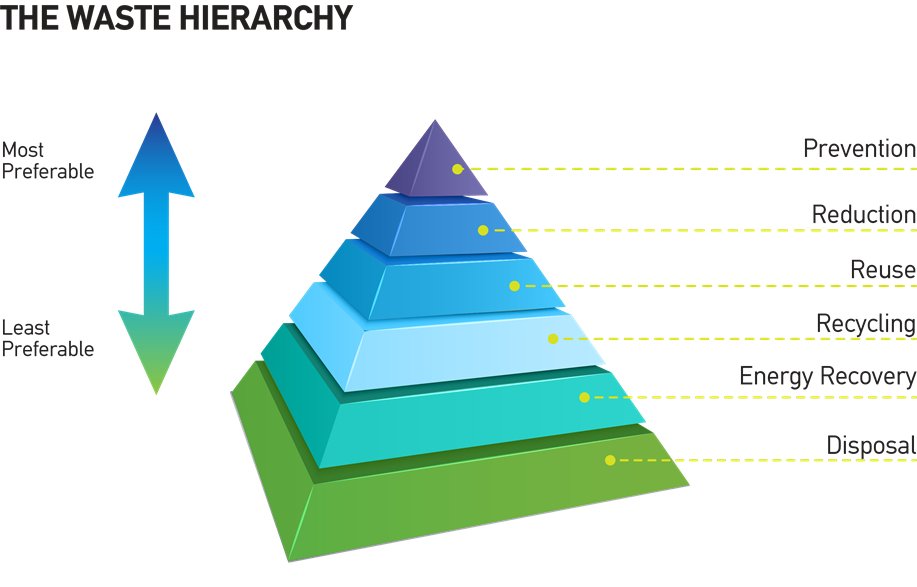
Details: BUSINESS-INFORM Review (issue #27, 2020)
|
|
|











 In English
In English
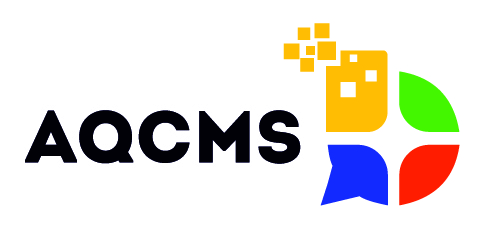


 In Russian
In Russian